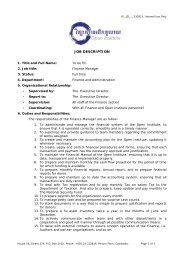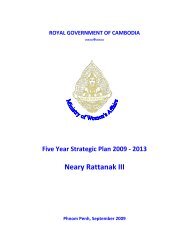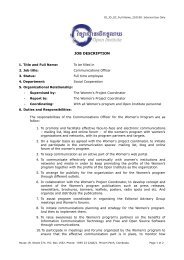Education Education An approach to some basic Indicators for ...
Education Education An approach to some basic Indicators for ...
Education Education An approach to some basic Indicators for ...
Create successful ePaper yourself
Turn your PDF publications into a flip-book with our unique Google optimized e-Paper software.
Catalog of indica<strong>to</strong>rs Introduction 7 3. Maternal mortality ratio per100,000 live birth10. Prevalence of major communicabledisease by sex and disease4. Under-five mortality rate by sex 11. Birth delivered assisted by skilledpersonal rate5. Immunization rate againstinfectious childhood disease by sexand immunization6. Accessibility <strong>to</strong> treatment, by sex,illness/deficiency and grade oftreatment7. Percentage of women withnutritional problem by cause12. Percentage of population usedcontraceptive method by sex and method13. Abortion rate14. Density of health personnel1.3.4. Work and Employment or Work and Labor sec<strong>to</strong>r(s)The labor issue is a central theme in the detection and dismantling the gender inequalities. Inthis sense, it is necessary <strong>to</strong> set the "traditional" differentiation between "productive labor"and "reproductive work". Almost exclusively women per<strong>for</strong>m reproductive work, while bothwomen and men are at productive works. Then, speaking of "work" we find a very firstsegregation by gender, beyond the existing segregation in the "productive work" or "labormarket".The relevance of the gender category at the macro level lies in its function of linking twodimensions that are complementary <strong>to</strong> the economy. On the one hand, the gender <strong>approach</strong>guarantees the existence of a non-remunerated work sphere, called reproductive work,where the labor <strong>for</strong>ce is reproduced and put in<strong>to</strong> circulation; and on the other, it conditionsalternatives in the remunerated work sphere, called productive labor. The intersection ofthese two spheres places women in a subordinated and disadvantaged position with regard<strong>to</strong> access and control of certain material and non-material resources necessary <strong>to</strong> reach ahigh level of well-being.In most societies women assume the majority of the responsibility of reproductivelabor involved in taking care of children and the home, tasks that tend <strong>to</strong> be perceived asfemales' natural function without any economic/social value. It is considered that the worksof reproductive nature do not generate income or status. Domestic or reproductive work isalready considered by the OECD as an indica<strong>to</strong>r of economic development (Society andGlance report 2011), creating potential <strong>for</strong> improving productivity and GDP of a country. Timeuse surveys are measurement <strong>to</strong>ols <strong>to</strong> help design public and moni<strong>to</strong>r policies, and give amore balanced view of well-being across different societies. Unpaid work - and especially thegender division of unpaid work - is <strong>to</strong> <strong>some</strong> extent related <strong>to</strong> a country's development level.The invisibility of female activity is determined by two fac<strong>to</strong>rs are not considered relevant orgenerating benefits <strong>for</strong> the economy and structural discrimination that relegates women <strong>to</strong>second place of employment, labor and the economy (Cooking, Caring and Volunteering:Unpaid Work Around the World. Veerle, Miranda; OCDE. 2011). Such an arrangement has led
















